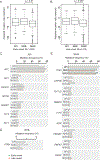Racial/Ethnic and Sex Differences in Somatic Cancer Gene Mutations among Patients with Early-Onset Colorectal Cancer
- PMID: 36520636
- PMCID: PMC10436779
- DOI: 10.1158/2159-8290.CD-22-0764
Racial/Ethnic and Sex Differences in Somatic Cancer Gene Mutations among Patients with Early-Onset Colorectal Cancer
Abstract
Molecular features underlying colorectal cancer disparities remain uncharacterized. Here, we investigated somatic mutation patterns by race/ethnicity and sex among 5,856 non-Hispanic white (NHW), 535 non-Hispanic Black (NHB), and 512 Asian/Pacific Islander (API) patients with colorectal cancer (2,016 early-onset colorectal cancer patients: sequencing age <50 years). NHB patients with early-onset nonhypermutated colorectal cancer, but not API patients, had higher adjusted tumor mutation rates than NHW patients. There were significant differences for LRP1B, FLT4, FBXW7, RNF43, ATRX, APC, and PIK3CA mutation frequencies in early-onset nonhypermutated colorectal cancers between racial/ethnic groups. Heterogeneities by race/ethnicity were observed for the effect of APC, FLT4, and FAT1 between early-onset and late-onset nonhypermutated colorectal cancer. By sex, heterogeneity was observed for the effect of EP300, BRAF, WRN, KRAS, AXIN2, and SMAD2. Males and females with nonhypermutated colorectal cancer had different trends in EP300 mutations by age group. These findings define genomic patterns of early-onset nonhypermutated colorectal cancer by race/ethnicity and sex, which yields novel biological clues into early-onset colorectal cancer disparities.
Significance: NHBs, but not APIs, with early-onset nonhypermutated colorectal cancer had higher adjusted tumor mutation rates versus NHWs. Differences for FLT4, FBXW7, RNF43, LRP1B, APC, PIK3CA, and ATRX mutation rates between racial/ethnic groups and EP300, KRAS, AXIN2, WRN, BRAF, and LRP1B mutation rates by sex were observed in tumors of young patients. See related commentary by Shen et al., p. 530 . This article is highlighted in the In This Issue feature, p. 517.
©2022 American Association for Cancer Research.
Conflict of interest statement
Figures



Comment in
-
Early-Onset Colorectal Cancer Somatic Gene Mutations by Population Subgroups.Cancer Discov. 2023 Mar 1;13(3):530-531. doi: 10.1158/2159-8290.CD-22-1464. Cancer Discov. 2023. PMID: 36855917
References
-
- Siegel RL, Miller KD, Goding Sauer A, Fedewa SA, Butterly LF, Anderson JC, et al. Colorectal cancer statistics, 2020. CA Cancer J Clin. 2020;70(3):145–64. - PubMed
Publication types
MeSH terms
Substances
Grants and funding
LinkOut - more resources
Full Text Sources
Medical
Research Materials
Miscellaneous

